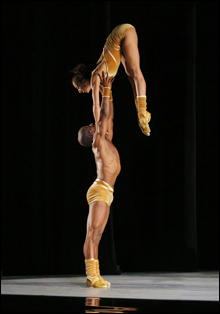
THE GOLDEN SECTION: Twenty-five years ago we’d never seen such dancing.
|
The Alvin Ailey American Dance Theater offered two milestones in the development of contemporary dance during its annual Celebrity Series visit to the Wang Theatre last week. The pairing of Ailey’s The River (1970-’71) and Twyla Tharp’s The Golden Section (1981-’83) allowed for a fascinating comparison between works that couldn’t have inhabited the same repertory without the Ailey company’s extraordinary vision. I wouldn’t have thought of Ailey and Tharp in the same breath, but the programming revealed some concerns they shared.
They were both modern dancers with an expansive view of the territory and an early belief in ballet training, if not the ballet vocabulary, as a basis for their choreography. They wanted to thrill, to entertain, to connect. For movement and thematic material they accessed vernacular modes, often portraying their dancers as everyday types the audience would recognize. They were eclectic in their musical tastes, venturing into jazz before it was acceptable for high artists to do that, but they brought contemporary and classical composers onto their stages as well.
Of course there were big differences between them. Unlike Tharp, whose instincts have been primarily structural, Ailey was committed to projecting social and spiritual uplift. He imagined a dance company and a repertory that would embody black accomplishment: physical mastery, beauty, and perseverance. But the company and the rep were always integrated, and Ailey, I think, saw his whole enterprise as a model for the dance world.
Created for American Ballet Theatre, The River wasn’t Ailey’s first ballet commission. He’d been a pioneer in the crossover from modern to classical dance, choreographing Feast of Ashes for the Joffrey Ballet, in 1962. In The River, he took on the full classical arsenal: pointe work, pas de deux, a large corps de ballet, and a cast of mega-stars including Cynthia Gregory, Natalia Makarova, and Erik Bruhn.
The score was commissioned from Duke Ellington, who delivered sections of symphonic jazz piece by piece as Ailey was working on the choreography. Ellington didn’t finish in time for ABT’s 30th anniversary celebration, and after showing the first six parts as a work-in-progress, Ailey completed it the next year. The River became a very successful addition to the ABT touring roster. Ailey took it off pointe when he transferred it to his own company in 1981, but it retains the lyricism and grandeur of its original conception.
With sections titled to suggest various watery sites, The River is a pure-dance work that fluctuates in scale, from ensemble (seven couples plus principal dancers) to smaller groups, duets and solos. Ailey had a subtext in mind, about birth, love, conflict, separation, community, independence, the whole human experience in fact. There are openings for characters to emerge, and some winks at ballet clichés. You may sense these meanings in the work now, but my impression last Thursday was that it’s become more of a feast for the eyes, technically terrific but a little bland.
No question about its success with the audience, which applauded as prompted by the blackouts between sections. Certain flamboyant cues, like a grinning woman being spun around by her partner in a split penché, also invited outbursts of approval. I find the permanent smiles and the calculated comic bits pretty flatfooted.
But Ailey’s group effects are impressive, something he isn’t particularly noted for. The ballet opens with a man on the floor, a dreamer, a symbol of youth (Clifton Brown), and seven couples in a pale light, streaming across the background with the women lifted high above their partners. In the jivy “Riba” section, Guillermo Asca bops around as a finger-clicking hepcat while the corps, in units of four, criss-cross horizontally, impersonating miniature chorus lines and the perennially quoted Cygnets from Swan Lake.
Linda Celeste Sims encounters Glenn Allen Sims in “Lake,” and their courtship is beautifully reflected by the other couples, not all of them heterosexual. (In 1970 this was probably the first gay outing on the ABT stage.) At the end of the ballet, “Twin Cities,” the corps becomes a powerful moving tide that separates Clifton Brown and Renee Robinson, a curiously pessimistic outcome for Ailey.
Ellington’s music seems to have been re-recorded sometime over the years, and parts of it felt drawn out, especially the last section, a hymnlike theme underlaid with a repeating note. Instead of urgently drawing you forward, the lagging tempo suggested something more ominous.
After its completion The River underwent changes in content and sequence. Ailey, like Twyla Tharp, frequently worked in suite form, with self-contained or even unrelated pieces of music, so he could make his dances serve different opportunities, updating them or tailoring them to fit dancers. Tharp does the same thing. The Golden Section was originally the finale of her ambitious full-length dance The Catherine Wheel.
With a commissioned score by David Byrne, The Catherine Wheel premiered at New York’s Winter Garden Theater in 1981, during a self-produced month of repertory by Tharp’s fabulous fusion company of modern and ballet dancers. She still thinks of it as a Broadway show, a forerunner of the Billy Joel hit, Movin’ Out. But it was a complex piece of serious choreography with literary and personal sources.